
Topics
Guests
- Fred Abrahamssenior researcher at Human Rights Watch’s Emergencies Program. He is the lead author of the report, 'White Flag Deaths: The Killings of Palestinian Civilians During Operation Cast Lead'
- Ambassador Daniel CarmonIsrael’s Deputy Permanent Representative to the United Nations
Human Rights Watch released a report last week detailing new evidence of possible Israeli war crimes committed during last winter’s Operation Cast Lead in Gaza that left over 1,400 Palestinians dead. The report says Israeli soldiers unlawfully shot and killed at least eleven Palestinian civilians, including five women and four children, who were in groups waving white flags to make clear that they were civilians and not combatants. We speak to HRW’s Fred Abrahams and air exclusive video from Gaza from Democracy Now!'s Anjali Kamat and Big Noise Film's Jacquie Soohen. [includes rush transcript]
Transcript
ANJALI KAMAT:
We go now to the Gaza Strip. The New York-based rights group Human Rights Watch released a report last week detailing new evidence of possible Israeli war crimes committed during last winter’s Operation Cast Lead in Gaza that left over 1,400 Palestinians dead.
The report says Israeli soldiers unlawfully shot and killed at least eleven Palestinian civilians, including five women and four children, who were in groups waving white flags to make clear that they were civilians and not combatants. It calls for an independent investigation into these deaths and prosecutions under international law if Israel fails to fairly investigate and prosecute those responsible.
AMY GOODMAN:
Well, the report was released last week, and it’s already come under heavy fire from the Israeli government and army spokespeople, who deny any wrongdoing on the part of soldiers. Israel has repeatedly blamed Hamas for the deaths of Palestinian civilians, claiming Hamas used civilians as human shields.
Well, we’re joined now here in our firehouse studio by the lead author of the report, “White Flag Deaths: The Killings of Palestinian Civilians During Operation Cast Lead.” Fred Abrahams is a senior researcher at Human Rights Watch’s Emergencies Program.
What did you find, Fred?
FRED ABRAHAMS:
Well, this was the fifth report we’ve issued on what Israel called Operation Cast Lead, and two of those reports were on Hamas violations, and three were on Israeli conduct.
Now, this last report looks at the deaths of eleven Palestinian civilians. Now, this is a small number compared to the total number of Gazans that were killed in the operation. But they’re significant, because in each of these cases, the civilians were in groups waving white flags. And we did in-depth research on the ground, visited the sites, interviewed the witnesses. And a crucial, key element is that in these cases there was no evidence of Palestinian fighters in the area at the time. And that’s key, because Israel has explained and justified many civilian deaths by saying Hamas was there using human shields. And in these cases, we didn’t find that to be the case.
ANJALI KAMAT:
Fred Abrahams, the Israeli government and the IDF have both responded to the report rather harshly. I spoke to Israel’s Deputy Permanent Representative to the United Nations, Ambassador Daniel Carmon, yesterday. He declined our invitation to appear on the program along with Human Rights Watch today, but responded to the report over the phone Sunday evening.
AMBASSADOR DANIEL CARMON:
Those kinds of reports — and we’ve seen a few in the last two months — tend to mislead in a conception that takes it into a generalized world. And I think that what we are confronted with is — we have a bigger picture. The bigger picture is a new phenomenon that the world is confronted with. And I can tell you firsthand, at the United Nations also, this new world of new kind of warfare, you know, people don’t know exactly how to confront this. On the one hand, a democracy, like Israel, with a free society, free press, everything is transparent, using and exerting its right to self-defense against terrorism. On the other side, a terrorist organization that has been occupying the territory of the Gaza Strip for a while now.
Human Rights Watch coming and investigating — and I think that we have a problem in the methodology of this investigation. They ask questions from people who cannot really say what they think, people who saw the systems and the way Hamas was fighting from within populated areas. And they were — they’re not only living in a territory occupied by terrorism, they are also under terror from their so-called leaders in the stronghold, terrorist stronghold, called Gaza.
ANJALI KAMAT:
But Ambassador Carmon, if I can interrupt for a second, I mean, reading and looking at Human Rights Watch’s methodology, and they’ve also put out a report, a statement, last week saying that, you know, it wasn’t just — first of all, they spoke to three eyewitnesses in each of the eleven incidents — seven incidents they looked at, eleven civilians being killed. They looked at ballistic evidence, medical records, interviewing multiple eyewitnesses, each person separately, not, you know, in a group. What is your problem with their methodology?
AMBASSADOR DANIEL CARMON:
Well, I understand that, and we appreciate any serious, credible investigation, but I would refer you, if I may, to a bigger, larger picture. Unfortunately, organizations like Human Rights Watch, I’m afraid to say, did not take the big picture into account.
ANJALI KAMAT:
But Ambassador Carmon, you’re speaking in very general terms. They speak quite specifically about seven incidents, eleven civilians — five women, four children — who were killed while there were waving white flags.
AMBASSADOR DANIEL CARMON:
I understand that, and I can tell you that I’m very proud to represent the country whose army, the IDF, is investigating, as a matter of regular procedure, any incident, any allegations that is submitted to it. It is doing so in a very clear — and under legal scrutiny. I can — I’d like to refer you — and if you’re really interested to know, we have put up on our website, and I encourage you to see this, a very comprehensive research, a 150-page report, that specifically talks about the larger picture, but also about the charges against Israel on various issues, including these particular charges against Israel on the issue of white flags, but also other incidents that were thoroughly investigated by the IDF.
ANJALI KAMAT:
Now, the press release from Human Rights Watch and the gist of the report says that the internal military investigations have been inadequate, and they’re urging more investigations into these specific cases. So, my question is, is the IDF going to look at these specific cases? Have they looked at them already, and will they look at them again?
AMBASSADOR DANIEL CARMON:
I can tell you that there is an ongoing investigation by the IDF, including on these allegations. And please, do yourself a favor and go into this 150-page report that we have put out. You will see a new, very professional look at what this operation in Gaza was all about, including — including those various allegations that the IDF is investigating internally.
ANJALI KAMAT:
Israel’s Deputy Permanent Representative to the United Nations, Ambassador Daniel Carmon. I reached him yesterday on the telephone. We invited him on the show, but he declined to come on with someone from Human Rights Watch and spoke to me over the telephone yesterday.
Fred Abrahams, what is your response? And can you respond specifically to two points that he made: one, that the Palestinian witnesses that you spoke to, somehow, that their testimony is suspect; and secondly, this internal investigation that he talked about, this 150-page report?
FRED ABRAHAMS:
Right. Well, the main criticism from the Israeli government of our report is attacking the methodology. And, you know, this is the same methodology we use all around the world, not just in Israel and Palestine. And it works. It relies on on-site visits and looking at ballistics evidence. We saw shell casings and ammunition boxes, tank tracks — excuse me.
And the key issue is the witnesses. They claim that you can’t trust a Palestinian witness. Now, you know, these are not one-off, quick interviews. These are almost deposition-like interviews that go on for many hours, sometimes revisited, at least three individuals separately for each attack.
And I really want to debunk the notion that these Palestinians won’t talk about Hamas. They will, and I know it, because I personally researched and wrote a report about Hamas violations against other Gazans. This is kneecappings, executions, disappearances against mostly Fatah members and supporters, but not exclusively. And what was the main source of our information for that report? It was Palestinian witnesses, and they spoke about it. They talked about how their relatives were taken away and are missing.
And so, it’s just untrue that Gaza is a homogenous terrorist den. There is a wide spectrum of views. As the incidents last week show, there was a battle between Hamas and a more extreme Islamist element that’s in Gaza. So you have a variety of views, and people will talk about Hamas.
AMY GOODMAN:
Anjali, you were in Gaza.
ANJALI KAMAT:
That’s right. I visited Gaza a month — two months after Israel’s Operation Cast Lead. And I was there in March. And I want to go to the story, one of the stories, that’s in your report. And it’s the story of forty-seven-year-old Rawhiya al-Najjar. She was shot and killed by a bullet to her head while she was waving a white flag.
ANJALI KAMAT:
I visited the village of Khuza’a in March of this year, nearly two months after the killing of Rawhiya al-Najjar. I met twenty-three-year-old Yasmine al-Najjar, who was walking right next to Rawhiya and was shot in the arm and the leg. On the morning of January 13th, Rawhiya had led a group of women out of their heavily shelled neighborhood. Yasmine described what happened as they walked toward the village center waving white flags.
YASMINE AL-NAJJAR:
[translated] Do you see that red door over there with the opening above the door? Rawhiya and I, and many other women and girls behind us, were walking this way, and we were waving flags. Suddenly, we saw one of the Israeli Special Forces come down the stairs from Faris’s house. And as we reached this point, it seemed by the way he was standing that he was aiming his gun at us. I took one step forward and saw a bullet hit Rawhiya right near her ear. Rawhiya fell down. Here, this is where she fell. I was here. Look, you can still see Rawhiya’s blood stains. I was here, and Rawhiya was over here.
ANJALI KAMAT:
I also spoke to Rawhiya’s fifteen-year-old daughter, Heba al-Najjar, who watched as her mother was shot and killed.
HEBA AL-NAJJAR:
[translated] The Israelis told us to leave and come towards the center of the village. So we left for the village center, and as we were walking, Special Forces who were in Faris al-Najjar’s house shot my mother in the head. I wanted to bring her back from there, but our neighbors and friends were nervous for my safety. I think her body lay there from about 8:00 in the morning until 8:00 at night.
ANJALI KAMAT:
People in the Najjar neighborhood were outraged that a group of unarmed women and children carrying white flags were targeted by the Israeli army.
YASMINE AL-NAJJAR:
[translated] They fired at us, even though we were holding white flags. What can that possibly mean? They meant to kill us. Their shots were intentional, as if they wanted to take revenge on us. We had children, we were waving white flags, but it was useless.
ANJALI KAMAT:
Another neighbor, an eyewitness, thirty-one-year-old Iman al-Najjar, echoed Yasmin’s sentiments as she spoke to me from the remains of her relatives’ home, burned out by white phosphorus the day before Rawhiya was killed.
IMAN AL-NAJJAR:
[translated] When they killed our neighbor, Rawhiya, she was holding a white flag. It was a white flag. She didn’t have any kind of weapon on her. Even so, they considered her a criminal, a part of the resistance, and they killed her in cold blood.
ANJALI KAMAT:
Iman then showed me the house from where the shots had been fired. She pointed out a hole in the wall with a direct view of the spot where Rawhiya and Yasmine had been shot.
IMAN AL-NAJJAR:
[translated] Rawhiya was coming from there waving a white flag. One soldier was looking out from here, and another one down, and fired a bullet that directly hit Rawhiya. She fell to the ground, but we couldn’t get to her. We tried several times to rescue her, but we couldn’t, because there was still heavy fire coming down on us.
ANJALI KAMAT:
That was Iman al-Najjar from the village of Khuza’a in Gaza, where — describing the shooting and killing of Rawhiya al-Najjar. I want to turn to another clip from another story that’s also in the Human Rights Watch report. This is the story of Khaled Abed Rabbo, whose two daughters, age two and seven, were killed in front of their home in Ezbat Abed Rabbo in Jabalya. Khaled Abed Rabbo took me to the spot where his daughters were killed, when I visited Gaza in March of this year.
KHALED ABED RABBO:
[translated] January 7th, it was a Wednesday, the Israeli army ordered us over a megaphone to leave our houses. We came out holding white flags — my wife, my mother and my three daughters and I holding white flags. We exited our house from there and came to this very spot. We stood at the spot for seven minutes, waving flags, waiting to see if they would let us enter our house or go somewhere else.
There was a tank there with two soldiers sitting on top of it. One was eating chips, and the other, chocolate. For seven minutes, we stood there without talking. Then, suddenly, one emerged from the tank and fired at the children. My daughter Amal, she was two years old, her intestines fell out. My daughter Suad, age seven, was also shot. My daughter Samar, age four, was shot in the back, chest and stomach; her spine was destroyed.
ANJALI KAMAT:
Suad died almost instantly, and Amal died of her wounds a few hours later, because no ambulances were allowed into the area. Samar is paralyzed from the waist down. Khaled Abed Rabbo’s mother was also seriously injured. When the family returned home towards the end of Operation Cast Lead, their home was a pile of rubble. I asked Khaled Abed Rabbo whether Hamas had a presence in the area.
KHALED ABED RABBO:
[translated] This is a border area. There’s no resistance here at all. The soldiers were eating chips and chocolate. How ironic that as my child were shot dead, the Israeli soldiers were eating chocolate. They were sitting on top of the tank, not even inside the tank. I mean, there’s no resistance here.
ANJALI KAMAT:
Khaled Abed Rabbo from Jabalya describing what happened to his two daughters.
Fred Abrahams, talk about — these are two of the seven incidents you investigated. Were these war crimes? What are you calling for?
FRED ABRAHAMS:
They’re highly suggestive of war crimes. Both cases are really strong. I mean, in the first, the soldiers ordered this group of women to leave the area. And they did, with Rawhiya al-Najjar waving a white flag. And as they approached the house, they came under fire, and she was killed. The second case is even, maybe, stronger because the family was standing outside their home, ordered outside by Israeli soldiers, and they came under fire.
But the key thing is there must be an investigation. And the point I want to make: the Israeli government claims — and in their big report that the ambassador was talking about, they claim they’re investigating also these two cases. One week ago, we called these two families and asked them a simple question: has anyone from the Israeli military or government contacted you to ask the basics of what happened to your family? The answer from both families was “no.” So, I want to place serious doubt onto the claim that this is an investigation. How much can they really be looking at it if they don’t ask the victims themselves?
AMY GOODMAN:
Fred Abrahams, we want to thank you very much for being with us, senior researcher in the Emergencies Program at Human Rights Watch; the name of the report, “White Flag Deaths: The Killings of Palestinian Civilians During Operation Cast Lead.”

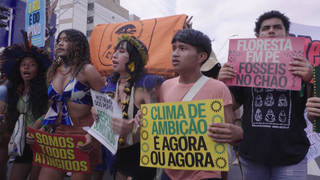
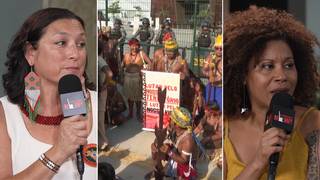
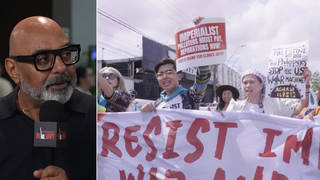
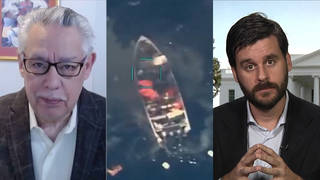





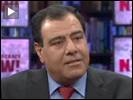
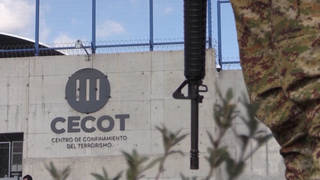
Media Options